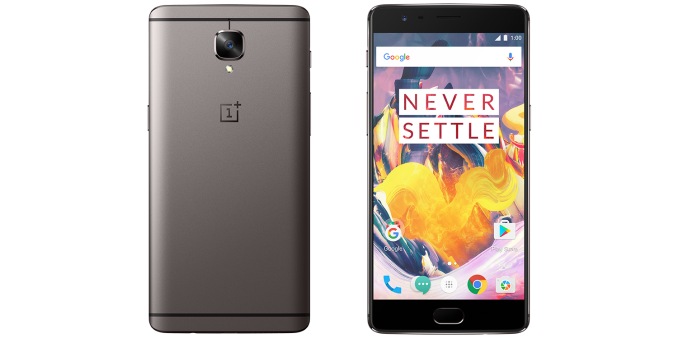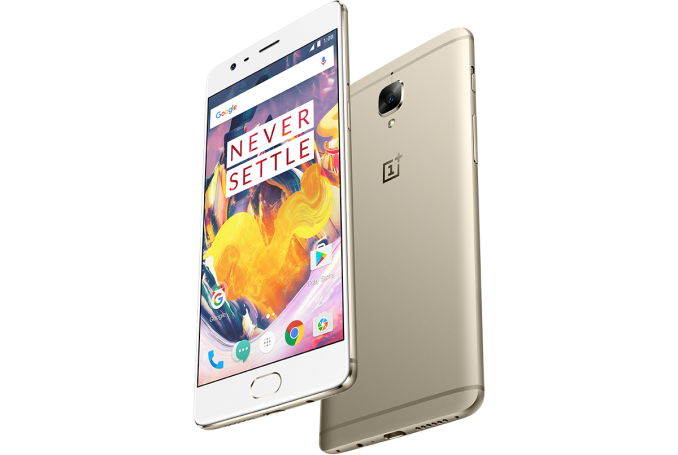OnePlus Launches The OnePlus 3T
by Brandon Chester on November 15, 2016 1:30 PM EST- Posted in
- Smartphones
- OnePlus
- OnePlus 3
- OnePlus 3T

Today OnePlus announced the OnePlus 3T, a smartphone that succeeds the OnePlus 3 as the company's flagship smartphone. This move may be unexpected for some, given that the OnePlus 3 only launched back in June of this year, meaning that its time as OnePlus's flagship phone lasted only five months. However, as technology moves forward, it makes sense to update devices appropriately even if the changes do not align with the yearly cadence that we've come to expect for mobile devices.
While the OnePlus 3T does succeed the OnePlus 3, owners of the OnePlus 3 do not need to fear that their device has been relegated to a position as a legacy device. As one might guess from its name, the OnePlus 3T is merely an iteration on the OnePlus 3 in order to take advantage of some technological improvements that have come along since the OnePlus 3's development cycle. Before going any further, I've made a chart comparing the OnePlus 3 and 3T so it's clear which aspects of the phone have changed.
| OnePlus 3 | OnePlus 3T | ||
| SoC | Qualcomm Snapdragon 820 | Qualcomm Snapdragon 821 | |
| GPU | Adreno 530 | ||
| RAM | 6GB LPDDR4 | ||
| Display | 5.5" 1920 x 1080 PenTile AMOLED | ||
| Size / Mass | 152.7 x 74.7 x 7.35mm, 158g | ||
| Battery | 3000 mAh | 3400 mAh | |
| Rear Camera | 16MP 1.1 μm Sony IMX298, f/2.0, OIS | ||
| Front Camera | 8MP 1.4 μm Sony IMX179, f/2.0 | 16MP 1.0 µm Samsung S5K3P8, f/2.0 | |
| Storage | 64GB UFS 2.0 | 64/128GB UFS 2.0 | |
| I/O | USB 2.0 Type-C connector, 3.5mm audio | ||
| Connectivity | 802.11a/b/g/n/ac + BT 4.2, USB-C, GPS/GNSS | ||
| Software | Android 6.0.1 OxygenOS 3.2.7 |
Android 6.0.1 OxygenOS 3.5.1 |
|
| Price | 64GB: 399 USD | 64GB 439 USD 439 EUR 399 GBP 599 CAD 3299 DKK 3388 HKD 4295 SEK |
128GB 479 USD 479 EUR 439 GBP 639 CAD 3599 DKK 3788 HKD 4795 SEK |
For the most part, the OnePlus 3T is essentially the same phone as the OnePlus 3. Both share the same ports, the same rear-facing camera, the same display, the same dimensions, and the same RAM configuration. What changes have been made are mostly improvements to internal components. Most notable is the move to Snapdragon 821, which helps keep OnePlus at the same level as the competition as far as processing power goes. OnePlus is using the standard MSM8996 Pro, which brings the peak CPU frequency to 2.35GHz and the peak GPU frequency to 653MHz, which will push performance slightly ahead of the OnePlus 3.
Moving beyond the SoC, the battery is definitely the next area of interest. OnePlus has maintained the size and mass of the OnePlus 3, but the battery capacity has increased 13% from 3000 mAh to 3400 mAh. Without a teardown it's hard to say whether this is owed to improvements in battery density, or improvements to the phone's internal layout, but given that the total platform power of the phone shouldn't be changing it should bring a noticeable improvement in battery life.
The last large change from the OnePlus 3 is the front-facing camera. The OnePlus 3 used Sony's IMX179, which is an 8MP sensor with 1.4 µm pixels paired with an f/2.0 lens. The OnePlus 3T bumps the resolution up to 16MP through the use of Samsung's S5K3P8 sensor with 1.0 µm pixels and the same aperture.
In addition to the changes mentioned above, the OnePlus 3T comes in a different set of colors and storage configurations than the OnePlus 3. The OnePlus 3 came in a standard aluminum finish, and only had a 64GB model. To differentiate it from its predecessor, the OnePlus 3T comes in a gunmetal grey finish and a gold finish, with the former shipping in 64GB and 128GB, and the latter only in 64GB. With all these changes also comes a roughly 10% increase in price, and it'll be interesting to see how the Android community feels about the balance of the price increase and the improved specifications.
The OnePlus 3T will be available for sale in the United States on November 22, and in Europe on November 28. With its launch, the OnePlus 3 is being sent to end-of-life status from a manufacturing perspective. However, the OnePlus 3 and 3T are viewed as essentially the same device from a software perspective, meaning that while you will no longer be able to buy the OnePlus 3, OnePlus plans to bring software updates to both phones. When the OnePlus 3 receives a stable release of OxygenOS 3.5.1 both devices should be updated on the same schedule going forward, with an update to Android Nougat expected to ship before the year is over.











35 Comments
View All Comments
LtGoonRush - Tuesday, November 15, 2016 - link
I'm happy with these changes, though I think the screen is still a dealbreaker for me. I'd be able to tolerate 1440p Pentile AMOLED, but 1080p isn't acceptable without an RGB layout.kpb321 - Tuesday, November 15, 2016 - link
Agreed. The screen type is far too often ignored in the resolution discussion. A Pentile AMOLED screen needs a higher resolution to compensate for the unusual and non-uniform pixel distribution than a RGB AMOLED or LCD screen does.ToTTenTranz - Tuesday, November 15, 2016 - link
Yup, Pentile 1080p on a 5.5" puts it rather far away from the ZTE Axon 7 IMO.SetiroN - Tuesday, November 15, 2016 - link
This so much.danielfranklin - Tuesday, November 15, 2016 - link
I thought this would have been the case too but ive been quite surprised at how little difference i can notice between my Oneplus 3 and my Galaxy s7 Edge when it comes to resolution.Ive used them both every day (work and personal phones).
eldakka - Tuesday, November 15, 2016 - link
Or shrink the whole phone down to a 5" screen, I'd be happier with that myself.Samus - Wednesday, November 16, 2016 - link
Don't ignore the 'benefits' to PenTile, such as improved battery life and obviously reduced cost. When you consider this phone beats $600+ phones on specs alone, the slightly bluer screen (which is often correctable with calibration/software if it bothers you) is passable for most people. I had no problem with the PenTile display in my GS3 and the technology has improved since then.philehidiot - Wednesday, November 16, 2016 - link
I think perhaps the problem with the pentile display isn't so much with normal use, it's that it really will impact on VR. When you take the trouble to make a phone daydream compatible and then put a screen like this on it, it's a bit silly really. I understand they're in a market they've helped build where you meet the spec of the big boys but keep costs low but.... they're increasing the price anyway and keeping a perfectly serviceable S820 model available so why not do it properly and have one cheap and one expensive version with the differentiating factor being one is only worth paying for if you want to use VR? The S821 seems to only be a slight upgrade to the S820 and probably won't be noticeable in real world use - it's sole reason for existing is certified daydream compatibility. It seems like a poor compromise to me. This should have been a 1440 screen or at least avoiding a pentile layout if they must keep 1080. I can see why they've done it as it saves costs in hardware and software development, sourcing as well as unit cost but still maddening to see a phone which probably wouldn't exist if it weren't for daydream compromising possibly the most important component of VR.edit1754 - Friday, November 18, 2016 - link
It may have its benefits, but my biggest issue with it is that it's not truly 1920x1080, and thus shouldn't be allowed to advertise with those numbers. PenTile displays have been invading the advertising space of other displays that do truly achieve their resolutions for a long time now, and the fact that they're allowed to do so I think is why we haven't seen higher-resolution true-RGB AMOLED displays.It's great that Anandtech is specific that it's PenTile in this article. A lot of tech blog writers don't even indicate that they're aware of this issue. But I think it should be on manufacturers and sellers to make it incredibly clear to consumers what they're buying, so as not to cover up such a substantial difference. So far there hasn't even been so much as an asterisk on these phones' product pages.
fred666 - Tuesday, November 15, 2016 - link
Clearly not worth the extra money over the non-T.